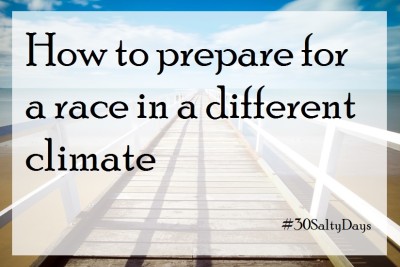I don’t typically run guest posts on my blog, but I’ve been an avid reader of the SaltStick blog for a while. Full disclaimer is that I haven’t tried SaltStick myself, but the research they post is always interesting and compelling! Please note that I am not being compensated for sharing this post; I just thought it would be valuable information to share.
During the #30SaltyDays campaign, SaltStick is publishing posts to educate people about the four major electrolytes lost through sweat (Sodium, Potassium, Magnesium and Calcium). Each week, a different electrolyte will be highlighted, and readers will learn things like how the electrolyte is used by the human body; examples of good, natural sources of the electrolyte; and examples of how professional athletes make use of the electrolyte in their nutrition strategy. I think this is pretty neat, as I honestly don’t know much about electrolytes other than “you need them” and “drink Gatorade.” 🙂 But electrolytes can make a huge difference in your race performance, so it’s incredibly valuable to learn more.
So without further ado, here are SaltStick’s tips on How to Prepare for a Race in a Different Climate!
With races popping up in luxurious locations throughout the world, the “destination race” has become popular in recent years. For example, Marathon Bahamas takes place every January, giving runners a break from the cold winter temperatures. However, the warm temperatures in the Bahamas also pose a training problem for runners: How can one train for the heat in the dead of winter?
Destination races aren’t the only races with this training conundrum: Events such as Escape from Alcatraz triathlon and Ironman Lake Tahoe have the reverse problem. Despite taking place in the warm months of May and September, these races are known for their cold conditions (especially in the water).

There are countless blog posts about the logistics of preparing for destination races (how early to get there, what to eat before the race, how much training should you do before the race, etc.), but these posts often neglect to mention how your body is going to react to the different climate. A trip to Miami in the dead of winter will no doubt be a nice change from the cold, but your body isn’t prepared to race in the hot and humid environment. Does that mean you should scrap the marathon and just enjoy Miami?
Not at all! If you are a regular reader of 50 by 25 (like we are!), you will see that Laura races throughout the year in many different climates. Destination races can be done and done well, as long as you take the steps to properly prepare.
How to prepare for a hot race in the cold:
Before the race: Two of the biggest changes the body undergoes when adapting to hot climates are (1) an increased sweat rate and (2) an increase in the concentration of blood vessels close to the surface of the skin. These changes help the body release excess heat quickly. To help prepare, try to include several training sessions per week in hot environments, to get your body used to sweating profusely.
- Take a hot yoga session or an indoor cycling class.
- If you run indoors, wear a few layers and resist the urge to shed them as you heat up.
- Spend an hour or two per week in a sauna — and if you don’t mind being that guy or girl — throw in some pushups and crunches while you’re inside. (Check with your physician if you have any underlying medical issues)
- If you are preparing for a swim in warm water, wear a wetsuit in the pool.
- Do anything you can to “get your sweat on.”
During the race: Another change your body undergoes in heat adaptation is to reduce the levels of salt in sweat. This means your sweat will be much saltier than a heat-adapted athlete, so you will have to take on more electrolytes. We recommend adding 1 – 2 SaltStick Caps per hour to replace electrolytes in the same ratio as lost in sweat.
It’s also harder for your body to process food when it’s overheated (as blood is shifted away from the digestive system to the skin to rid the body of excess heat), so be sure to alter your race nutrition to include a greater amount of calories from liquid sources.
Finally, take it slow, or at least slower than you would in the cold. It’s much easier to recover from getting too cold during a race than getting too hot. Once you are overheated, your body will force you to slow down well beyond race pace, and your chance for a PR will be over. Slow and steady wins the race in a cold-to-hot scenario.
How to prepare for a cold race in the heat:
Before the race: While heat adaptation increases sweat rates and the concentration of blood vessels near the skin, cold adaptation involves the opposite. Unfortunately, it’s difficult to “trick” your body into adapting to the cold weather when it’s 85° and sunny. The best thing you can do is avoid working out in the hottest part of day, although this will only have minimal benefits. Most of your strategy will involve race-day changes to your routine.
During the race: Luckily, a heat-adapted athlete can race quite well in cold conditions, provided he or she is smart about race day. You will need less water than in hot conditions; however, your total caloric needs will be the same. During the race, you should alter your race nutrition to include more calories from solid foods, such as gels or bananas.
Also, be careful not to make the rookie mistake of wearing too many clothes — even in 50° weather, shorts and t-shirt will be fine. After the first few miles of the race, your body will warm up.
Finally, like we blogged about last winter, you still need electrolytes! We suggest taking 1 – 2 SaltStick Caps per hour to maintain optimal levels of sodium, potassium, calcium, chloride and magnesium.
How to prepare for a humid race in dry heat:
Before the race: Like we recently blogged about, the body sweats more in humid weather than in dry weather in attempt to increase the rate of evaporation, which promotes cooling. Humid weather can feel much hotter than dry weather at the same temperatures because the body’s ability to cool itself with sweat is greatly diminished. Preparation is similar to preparing for a cold-to-hot race.
- If you live in a dry area, such as Las Vegas or Denver, spend some time in a sauna to get the feel for humidity.
- It is also a good idea to practice mental training — by repeatedly reminding yourself it will feel much harder on race day, the increased strain that accompanies humidity won’t be too much of a surprise.
During the race: Remember the mental training you did in practice! Recognize the same temperatures will feel much hotter in humid environments, and expect to be a little slower.
Take every opportunity to douse yourself with cold water or ice. If you are not adapted to the humidity, your sweat rate will be lower, which hampers cooling. The cold water will help lower skin temperatures through convection.
Also, you will want to help the sweat process work, which means you should take every opportunity to allow your sweat to evaporate. Avoid wearing cotton clothing, and choose a visor over a hat.
How to train for a dry-heat race in the humidity:
Before the race: There is little change that needs to be made before racing in a hot environment, except to establish a race-nutrition process. If you are training in a humid environment, your sweat rate will be very high, which means you will dehydrate quickly in a dry environment. Be sure to practice reminding yourself to drink water at regular intervals in your training sessions. During the race, those little reminders will be automatic.
During the race: Do not be surprised if you find yourself constantly thirsty in the heat. Your sweat rate will be very high coming from a humid environment, so you will need to drink plenty of water to stay hydrated, even if you do not see the sweat pooling on your skin.
Also, dry heat can be deceptive: Because your sweat evaporates so quickly, it may not feel very hot, which means you run the risk of overheating if you don’t take it easy. Run the first few miles of the race at an easy pace to get used to the change in climate, and do not run harder than you would in a humid environment. Overheating is overheating, and it can happen just as easily in dry heat as in humid heat.
The bottom line: Racing your destination race can be easy, as long as you take the steps to get ready. If you’re mindful of the changes that happen to your body when adapting to new climates, you can do your best to prepare now to make that change easier.
Note from SaltStick: This post is part of our #30SaltyDays summer campaign, in which we hope to educate YOU about the benefits and science behind electrolytes. Follow the campaign with the hashtag #30SaltyDays on Facebook, Twitter, Instagram and the SaltStick blog. We’re offering our brand new product, SaltStick Fast Chews, as a giveaway for participants. More information here.
Thank you to SaltStick for sharing this great info!!



One advantage of living in PHX is that any race is almost ALWAYS going to be less hot than it is here. The downside is that it is always going to be MORE humid. I really really struggle w/ the humidity. Partly because I don’t run in it (ever), but also because I sweat…A LOT. I’ve actually used salt pills / capsules with some success. Hopefully i’ll get the chance to use them again sometime really soon.
I find running in humidity to be REALLY tough… even more so now that I live in Colorado.